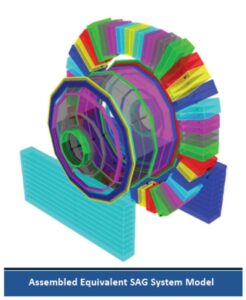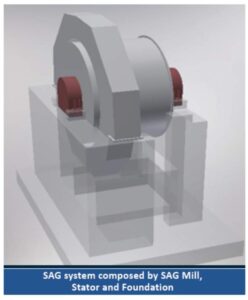
Guillermo Etse - CEO
Computational Dynamic Seismic Analysis of SAG and BALL Mill systems
SAXUM has proposed an effective and efficient procedure and computational approach based on the Finite Element Method for the dynamic seismic interaction analysis of highly complex systems such as those of SAG and Ball Mills involving three components: the mill, its stator and foundation. The main advantage of the proposed procedure is its effectiveness in accurately predicting the most critical stresses in the different components, and also of the resulting maximum/ minimum displacements (total and relatives), velocities and accelerations. Particularly, the mathematical model obtained with SAXUM proposed procedure allows accurately predicting the gap between the Stator and the SAG or Ball Mills caused by the dynamic interaction during seismic excitations.
The proposed novel procedure allows accounting for all involved complexities of the considered dynamically interactive system, including the spatial mass and stiffness distributions of all components, both in transient and steady (operational) states, the electromagnetic and/or mechanical forces, the presence of highly complex boundary conditions and interfaces between the involved components, etc. All these variables and complexities are taken into account and accurately modelled in the framework of a very efficient technique that allows very fast computational analyses and numerical resolutions within high accuracy levels.
SAXUM’s proposed procedure for dynamic performance analyses of highly complex dynamically interactive systems was applied for evaluating the dynamic seismic performances of the SAG and Ball Mill Systems designed by Symens and Metso for the Quellaveco project of Anglo American in Peru. The models developed by SAXUM for the purpose of the dynamic seismic analyses of both, SAG and Ball Mill Systems of the Quellaveco project, account for the mass and stiffness features of each component of both dynamically interactive systems, and for their highly complex variations in all three spatial dimensions.


Despite the relevant complexities involved in the modelling of stiffness, mass distribution, loads, geometry, supporting conditions, component interfaces, material mechanical properties, etc., SAXUM’s procedure allows a straightforward and relatively simple methodology for model development. Nevertheless, and for the sake of accuracy of the numerical predictions, the application of SAXUM’s procedure requires highly experienced and capable professionals with deep knowledge of structural dynamics, finite element method, mechanics of materials, and soils dynamic. Moreover, the expert responsible for the model development needs to be supported by professionals with deep knowledge of the mechanical and structural features of each involved component of the analyzed dynamically interactive system. In the case of the SAG and BALL Mill System Models of the Quellaveco Project developed by SAXUM for their dynamic seismic performance analysis, the calibration of the considered internal parameters and mechanical features for each component was performed by comparing one by one the eigenmodes and eigenfrequencies of each isolated component of the system, as predicted by SAXUM model with the results predicted by very detailed 3D models of each component developed by the equipment suppliers (Siemens and Metso). On the other hand, the calibration of the considered overall boundary conditions of the SAG and BALL Mill Systems, and of the inter- faces between the different components of each system, was performed by comparing the resulting dynamic features of each system predicted by SAXUM’s equivalent models with those dynamic features obtained by means of very detailed mathematical models of each system. These detailed system models which were developed by SIEMENS required very long periods of time (several months) due to needing to include every single detail of each component (mill, stator and foundation). Differently, the efficient models developed by SAXUM based on the procedure proposed by our company were completed and calibrated within a few weeks. The results demonstrated the accuracy of the methodology and results.
The solutions obtained by SAXUM of the dynamic seismic interactive performances of the SAG and BALL mill systems for the Quellaveco Project, were used for determining maximum stresses in the foundation, stator and mill, as well as the entire kinematic field (displacements, velocities and accelerations). More importantly, the results included the predictions of the SAG and BALL mill foundation kipping due to the expected seismic excitations and of the maximum eccentricities of the soil reactions. These results, together with the predictions of the variation of the stator to mill gap during the dynamic performance allow verifying both, the dynamic stability and the appropriateness of the SAG and BALL Mill Systems regarding the expected seismic excitations at Quellaveco.
The efficient and simplified procedure proposed by SAXUM for dynamic seismic analysis can be utilized for any dynamically interactive system. This includes vertical mills of cement plants, whereby the Mill interacts with its foundation and the surrounding soils, as well as systems composed of multiple dynamic equipments (mills, process fans, kiln, stator, etc.) which dynamically interact through the subsoils.
Latest news
- The Story Behind the Partnership – SAXUM/Lycopodium 6 August, 2025
- SAXUM´s Newsletter Issue #251 – May 2025 21 May, 2025
- SAXUM Joins Forces with Lycopodium 18 February, 2025
- SAXUM´s Newsletter Issue #242 – December 2024 9 December, 2024
- SAXUM´s Newsletter Issue #241 – May 2024 1 May, 2024
- SAXUM´s Newsletter Issue #232 – Dec 2023 14 November, 2023
You must be logged in to post a comment.